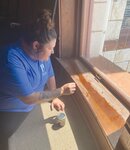

You may remember the old saying about a person having a “bee in their bonnet,” but how about having bees in your attic? The Coryell County Courthouse has a very large attic – possibly the largest one in the county, and yes, it has been home to a beehive which is estimated to be 30 feet in circumference.
After doing a Google search for “courthouse bees,” the same problem has been reported in several courthouses and government buildings across the United States. It is not an unusual occurrence, but perhaps the size of this particular beehive will rank as one of the largest.
Tiffany Butler, who has worked in the building for four years, said that since she’s been there, “we have had two active hives that I’ve known of. We had one outside on the north peak above the front porch that dripped honey on the courthouse steps and the larger one in the courthouse attic.”
Butler remarked, “The bees are almost as historic as the building.”
Concerning the massive hive in the attic, bee removal firms in the Dallas/Ft. Worth area as well as in Austin were contacted and all agreed that the only solution to removing the hive would be to cut a hole through the wall. That could not be considered an option due to the fact that the structure cannot be altered since the courthouse has been on the National Register of Historic Places since 1977 and is now protected by the Texas State Historical Commission. Therefore, there was no other way to remove the bees other than extermination.
Today, the decaying beehive continues to seep honey from the attic into the third-floor balcony of the 52nd courtroom. Butler stated that she has to clean honey out of the windowsills and remove dead bees approximately every two weeks.
In years past, when the massive number of bees were still active, Butler said that you could feel the vibration of the bees. “You could put your hands on the windows and walls and feel the vibration from the bees who were swarming in the attic,” she said
“No one has been stung in the balcony that I know of,” she said. “Most of the bees congregate in the balcony area. In the past, when they were active, I would try to vacuum the bees and let them out of the vacuum cleaner outside. I didn’t want to kill them intentionally but release them outside.”
Butler often gives courthouse tours and relates the history of the building to visitors. Most of those taking the tour are interested in seeing the bullet holes in the District Courtroom where, in 1909, Verna Ware opened fire and killed a man who was on trial for her rape. That story has always drawn visitors to the building. Today, Butler reports that visitors are now drawn to the balcony area to see the honey.
“Recently, people have been referring to this as the ‘Bleeding Courthouse’ – it bleeds honey. I’ve had two tour groups at least who have said they heard that the building is bleeding honey and wanted to see it. It’s definitely been something that has caused more of an attraction to the building – just how many buildings today do you see that have honey seeping down the walls and into the courtroom?”
“The bees are gone, but the honey is still there. Unfortunately, this is something we’re just going to have to deal with every year now and probably forever as the hive is renewed by new queens.”